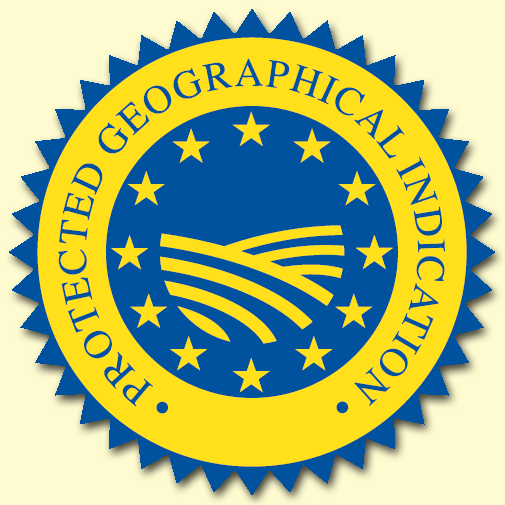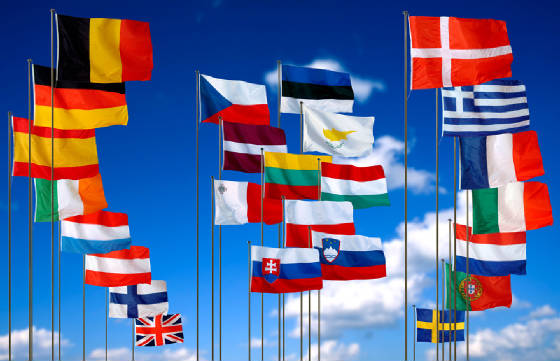This system is similar to Appellation systems throughout the world,
such as the Appellation d'origine contrôlée (AOC) used in France, the Denominazione di origine controllata (DOC) used in Italy, the Denominação de Origem Controlada (DOC) used in Portugal, and the Denominación de Origen (DO) system used in Spain. In many cases, the EU PDO/PGI system works parallel with the system used in the specified country, and in some cases is
subordinated to the appellation system that was already instituted, particularly with wine, for example, and in France (in
particular) with cheese, for example Maroilles (as most others) has both PDO (AOP in French) and AOC classifications, but generally only the AOC classification will
be shown.
The World Intellectual Property Organization (WIPO) defines a geographical indication (GI) as “a sign used on goods that have a specific geographical origin and possess
qualities, a reputation, or characteristics that are essentially attributable to that origin.” An appellation of origin (AO) is a common form of a GI that consists of either a geographical name or a traditional
designation used on products that suggests specific qualities or characteristics, which are attributed to the geographical
environment in which they are produced. Frequently, GIs are associated with and include the name of a product’s
place of origin.
Geographical indications may be used for a wide variety of products whether organic or manufactured. Agricultural products
are often associated with their region of production because such products are generally a result of local climate, sunshine,
and soil that are specific to a particular region. For example, Napa Valley is reputable for its wine, Tuscany for its olive
oil, and Roquefort for cheese. These generally have GI protection. National laws dictate whether GIs qualify for protection.
GIs may serve as a successful marketing tool because they help customers associate the product with a level of quality. Companies
that sell products where a specific characteristic of that product relates to a geographical origin should consider obtaining
GI protection.
Legislation
GIs are protected in accordance with international, EU, and national laws. For example, trademark laws in the form of collective
marks or certification marks, unfair competition legislation, consumer protection laws, or specific laws that recognize individual
GIs.
International Laws
WIPO administers multiple international treaties that address GI and AO protection, notably the Paris Convention for the Protection of Industrial Property and the Lisbon Agreement for the Protection of Appellations of Origin and their International Registration.
The Lisbon System, which was established under the Lisbon Agreement was established to facilitate the international protection of AOs. The system offers a means
of obtaining protection for an AO in the contracting parties to the Lisbon Agreement through a single registration. Registrations
can be searched through the Lisbon Express database.
In addition, Articles 22 to 24 of the Agreement on Trade-Related Aspects of Intellectual Property Rights (TRIPS) address international protection of geographical indications within the WTO
framework.
WIPO works with Member States and interested organizations in the Standing Committee on the Law of Trademarks, Industrial Designs and Geographical Indications (SCT) to develop the international legal framework for GIs.
European Union Laws
In 1992, the EU established a method for companies to gain unitary GI protection throughout the EU-27 Member States. The
EU offers specific GI protection for wines, spirits, and mineral waters. If the EU has not developed legislation for a specific
GI, GIs may be registered as a certification or collective mark under either or both a Member State’s national law and/or
as a Community Trademark.
As mentioned, the US and the EU have disputed over the EU’s legal regime and in 1999 the US and Australia brought
dispute settlement proceedings against the EU before the World Trade Organization (WTO). After the WTO panel held in favor
of the US and Australia, in 2006, the EU updated its GI Regulation to grant equal protection to GIs properly filed in Europe.
The EU protects GIs that qualify as designations of origin or geographical indications and that have not become generic.
To qualify as a Protected Designation of Origin (PDO) or Protected Geographical Indication (PGI), a product must comply with
specifications for describing the “principal physical, chemical, microbiological or organoleptic characteristics”
of the product, and also list the geographic area from which it originates that gives rise to such a product’s unique
proprietary traits.
A “designation of origin” refers to a region’s name and will be protected if the designation fulfills
three conditions: (1) the product must originate in that geographical area, (2) the quality or characteristics of the product
must be essentially or exclusively due to a particular geographical environment with its inherent natural and human factors,
and (3) production, processing and preparation of the product must take place in the defined geographical area.
Essentially, the only requirement for a word to become a PDO is a connection between land and the qualities of the product.
A traditional non-geographical name designating a region or a specific place may also be registered as a PDO if it fulfills
the conditions above.
A “geographical indication” also refers to a region’s name and is also subject to three conditions: (1)
the product must originate in that geographical area, (2) a specific quality, reputation or other characteristic that is attributable
to that geographical origin, and (3) the production and/or processing and/or preparation of the product takes place in the
defined geographical area.
A main difference between PGIs and PDOs is that PDO products are generally more connected to the product’s qualities
and the land, whereas PGIs must only be attributable to the product’s geographical origin. Also, to be granted PGI protection,
an applicant need only establish that one of the elements of production, processing, or preparation takes place in the geographical
area. Traditional non-geographical names designating regions or specific places may also be registered as a PGI.
It is not possible to register PGIs as symbols. To date, there is no obligation for GIs to indicate that the name of a
product marketed under a registered PDO or PGI is a registered designation. If a product is placed on the European market
after April 30, 2009, the company must properly mark the product’s label as receiving EU GI protection.
Coverage
EU GI protection prohibits any misuse, imitation, or evocation of registered GIs, even where an unprotected product indicates
its true origin, or where qualifiers such as “method,” “style,” and “type” accompany the
name of an unprotected product. The GI Regulation also prohibits any false or misleading indication as to the provenance,
origin, nature or essential qualities of a product any other practice that could mislead consumers.
Registration
If your company has an EU office, that office may file a GI application for registration with the Member State’s
national authority. However, if your company does not have EU representation, it may either file an application with the EU
Commission or the Member State authorities. The relevant national authority conducts an initial examination of the GI application,
and forwards the application to the EU Commission for a review. If your company’s product originates from outside of
the EU, only the European Commission will review its application.
If the Commission approves the GI registration application, the relevant authorities will publish your company’s
PDO or PGI and the specifications for such a GI, in the Official Journal of the European Union. For six months after the date
of publication, parties may object to a proposed PDO or PGI. Any natural or legal person, inside or outside of the EU who
has a legitimate interest in the outcome of the GI registration application may file an objection. Natural or legal persons
in an EU Member State outside of the Member State where the application originated must file objections with the competent
authorities in their home Member State within a limited and reasonable period established nationally but not to exceed six
months. If there are no objections to the GI application, the GI will be registered as either a PDO or PGI.
Helpful Links & Sources
Annette Kur and Sam Cock’s Article: Nothing but a GI Thing: Geographical Indications under EU Law, May, 8, 2007,
available at https://law.fordham.edu/publications/articles/200flspub8031.pdf
Council Regulation on the Protection of Geographical Indications and Designations of Origin for Agricultural Products and
Foodstuffs:
http://eur-lex.europa.eu/LexUriServ/site/en/oj/2006/l_093/l_09320060331en00120025.pdf
National Authority for Geographical Indications:
http://ec.europa.eu/agriculture/foodqual/protec/national/index_en.htm
TRIPS Agreement:
http://www.wto.org/english/tratop_e/trips_e/t_agm0_e.htm
WIPO Gate for GIs:
http://www.wipo.int/about-ip/en/geographical_ind.html


